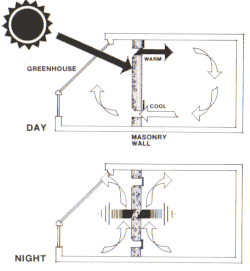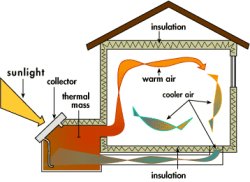Passive Solar Heating and Cooling


There are three major ways to passively use solar energy to heat a building, and two of them can actually be used to cool it as well.

On the sun side of the building (the south side in the northern hemisphere and the north side in the southern hemisphere), create an overhang, typically the roof of a patio, porch, deck or veranda. This overhang is narrow enough to bathe the building in sunlight during the wintertime when the sun is low, yet wide enough to put the building in shade during the summertime when the sun is high. Thus, in the winter the sun helps heat it, and in the summer the shade helps keep it cool.
The sun-side of the building is built with a dense heat-absorbing material, such as masonry, concrete, stone, brick, adobe or rammed earth. Similarly, the floors are also covered with a dense heat-absorbing material, such as tile, so that solar energy pouring through the windows in the winter is absorbed by the floors and radiated back as infrared heat. At night the heat absorbed by walls and floors during the day helps heat the interior space.
Using plants to passively control direct gain heating and cooling is often overlooked. This strategy uses disciduous plants, ones that go dormant and shed their foliage in the winter, to put the sun side of a building in shade in the summer, but let the sun hit the building in the winter when it sheds its leaves. These can be trees, high enough to shade the building in the summer, plants on a trellis, etc.

A variation of indirect gain heating is to simply build a greenhouse or solarium along the sun side of the building. The greenhouse effectively turns the existing sun-facing exterior wall into a solar wall. This not only helps heat the sun side of the building, the greenhouse is insulated on the side attached to the building (an advantage over a detached greenhouse), and it provides convenient ready access from the building to the greenhouse. In the summertime the windows in the greenhouse could open so that it doesn't heat the sun side of the building.
A solar wall or south-side greenhouse can also actually help cool a building in the summer with a technique that is especially effective when the ambient air in the shade is tolerably cool. It works like this. Vents are located low on the side of the building away from the sun where relatively cool air is along the shaded ground. The vent on the bottom of the solar wall is open, but the vent on the top of the wall is closed. Instead, a vent on the top of the sun side window or greenhouse is open.
This way, the solar wall creates convection which pulls air from the vent on the shaded side of the building, through the space, up between the solar wall and the window or greenhouse, and then out through its vents. When humidity is low, this effect can be optimized by something wet on the side of the building opposite the sun, like a pool of water, which further cools the air by evaporation like a swamp cooler, the same way your body cools itself by sweating. Another way to optimize effect is to pull cool air from underground pipes, ducts or an underground space like a root celler. This technique combines passive solar cooling with passive geothermal cooling.

The collectors are placed below the thermal storage, which in turn is placed lower than the space it is to heat. The hot fluid rises from the collectors through pipes or ducts to the thermal storage, which absorbs the heat from the fluid then transfers it into the building space. Having lost its heat, the fluid then falls by convection back to the bottom of the collectors to be reheated.
Wherever possible design new buildings and retrofit old buildings to heat (and cool) themselves with passive solar systems. The most simple and inexpensive of these use overhangs and foliage on the sun side of buildings for direct gain heating.